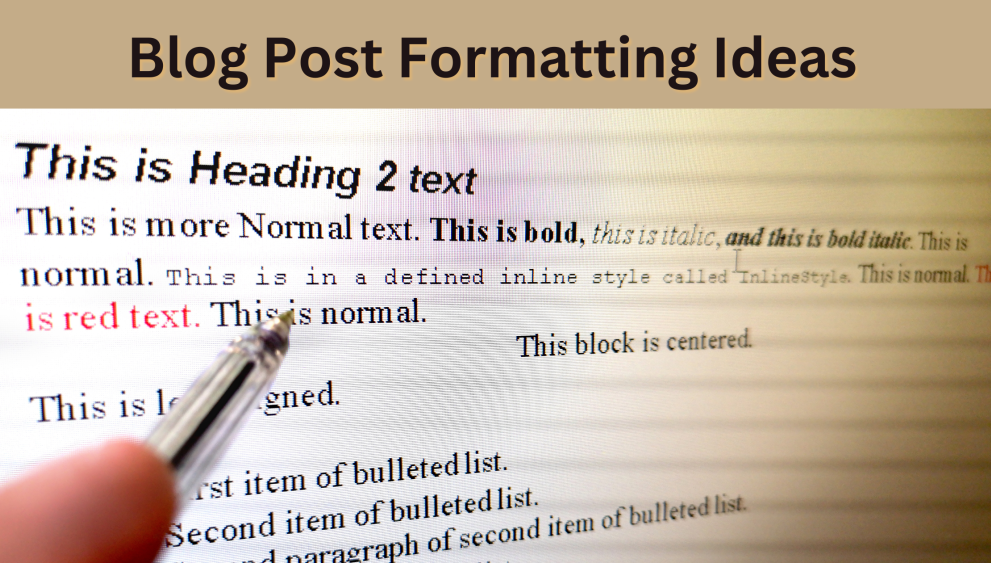
In the vast ocean of the internet, where countless blogs compete for attention, standing out can feel like an insurmountable challenge.
Yet, amidst this sea of content, one powerful tool can make all the difference: creative blog post formatting.
Welcome, fellow bloggers and aspiring writers, to a journey of discovery where we unravel the secrets of captivating formatting that will elevate your blog posts to new heights.
Why does formatting matter, you may ask?
Well, imagine stumbling upon a wall of text with no breaks, no headings, and no visual elements to guide your eyes.
Would you dive in eagerly, ready to soak up every word, or would you quickly click away in search of something more digestible?
The truth is, in today’s fast-paced digital world, readers crave content that is not only informative but also visually engaging and easy to consume.
That’s where creative formatting comes into play.
By strategically breaking up your text with subheadings, incorporating lists and bullet points, using bold and italics for emphasis, adding eye-catching visuals, and experimenting with different font styles and sizes, you can transform a mundane blog post into a captivating masterpiece.
Throughout this article, we’ll explore each of these formatting techniques in detail, providing practical tips and inspiring examples to ignite your creativity.
Whether you’re a seasoned blogger looking to breathe new life into your content or a novice writer eager to make a memorable impression, you’ll find valuable insights and actionable advice to propel your blog to success.
So, buckle up and prepare to embark on a journey of exploration and experimentation.
By the end of this article, you’ll not only understand the importance of creative blog post formatting but also possess the knowledge and tools to implement these strategies in your writing.
Get ready to captivate your audience, elevate your content, and leave a lasting impression in the crowded landscape of the blogosphere.

1. Break up Your Text with Subheadings
In the vast expanse of cyberspace, attention is a scarce commodity.
Readers often skim through content, searching for the information that resonates with them.
Subheadings act as signposts, guiding readers through your blog post and helping them navigate to the sections that interest them most.
Why Subheadings Matter
Imagine opening a blog post only to be greeted by a daunting wall of text.
It’s overwhelming, isn’t it?
Subheadings provide structure and organization, breaking up your content into manageable chunks.
This not only makes your blog post more visually appealing but also enhances readability, allowing readers to quickly grasp the main points of your message.
Tips for Effective Subheadings
- Keep it concise: Aim for subheadings that are clear and to the point. Long, convoluted subheadings defeat their purpose by adding complexity instead of clarity.
- Use descriptive language: Your subheadings should give readers a glimpse of what each section is about. Use descriptive language that accurately reflects the content that follows.
- Create hierarchy: Use a consistent formatting style for your subheadings to create a sense of hierarchy. This helps readers understand the structure of your blog post at a glance.
Examples of Effective Subheadings
- The Power of Storytelling: Exploring the impact of narrative techniques in blog writing.
- Tips for Effective SEO: Strategies to optimize your blog post for search engine visibility.
- The Future of Blogging: Predictions and trends shaping the landscape of online content creation.
Call to Action
Ready to transform your blog posts with the power of subheadings?
Experiment with different styles and structures in your next piece of writing.
Keep your readers engaged and make your content more accessible with strategic subheadings that guide them through your message.
2. Incorporate Lists and Bullet Points
In the fast-paced world of online reading, attention spans are short, and readers often skim through content rather than reading every word.
This is where the strategic use of lists and bullet points can make a significant difference in capturing and retaining your audience’s attention.
Why Lists and Bullet Points Work
Lists and bullet points break up dense blocks of text, making information more digestible and easier to scan.
They provide a visual cue that signals important points or key takeaways, drawing the reader’s eye and guiding them through the content in a structured manner.
Additionally, lists and bullet points help to prioritize information, highlighting the most crucial details and making them stand out amidst the surrounding text.
Tips for Effective Use
- Keep it concise: Each item in your list or bullet point should be brief and to the point. Aim for clarity and avoid unnecessary elaboration.
- Use parallel structure: Maintain consistency in the structure and formatting of your lists and bullet points to ensure readability and coherence.
- Highlight key information: Use lists and bullet points to emphasize key points or action items, making them more memorable for your readers.
Examples of Effective Implementation
- Top 10 Tips for Healthy Eating:
- Eat plenty of fruits and vegetables.
- Stay hydrated by drinking water throughout the day.
- Limit processed foods and sugary snacks.
- Incorporate lean protein sources into your meals.
- Practice portion control to avoid overeating.
- Benefits of Regular Exercise:
- Improves cardiovascular health.
- Boosts mood and reduces stress.
- Increases energy levels and stamina.
- Helps maintain a healthy weight.
- Enhances overall quality of life.
Call to Action
Ready to enhance the readability and engagement of your blog posts?
Experiment with incorporating lists and bullet points in your next piece of content.
Whether you’re sharing tips, outlining steps, or highlighting benefits, lists and bullet points can help you communicate information more effectively and keep your readers coming back for more.
3. Use Bold and Italics for Emphasis
In the vast landscape of online content, where distractions abound and competition for attention is fierce, it’s essential to make your key points stand out.
Bold and italics are powerful tools in your formatting arsenal, allowing you to emphasize important words or phrases and capture your readers’ attention.

The Power of Bold and Italics
Bold text commands attention. It adds weight to your words, making them stand out from the surrounding text and signaling to readers that these are points of particular significance.
Italics, on the other hand, convey a sense of emphasis or emphasis, drawing the reader’s eye and adding nuance to your writing.
Tips for Effective Use
- Use sparingly: Reserve bold and italics for key points, important terms, or phrases that you want to highlight. Overusing them can diminish their impact and make your text appear cluttered.
- Be consistent: Establish a clear system for when to use bold and when to use italics, and stick to it throughout your blog post. Consistency in formatting helps maintain readability and professionalism.
- Avoid mixing styles: While it’s tempting to combine bold and italics for added emphasis, this can sometimes confuse readers. Stick to one style or the other, depending on the context and the message you want to convey.
Examples of Effective Implementation
- Key Takeaway: Consistency is key when building a successful blog.
- Pro Tip: Use italics to add emphasis to important points in your writing.
Call to Action
Ready to make your key points pop and grab your readers’ attention?
Experiment with bold and italics in your next blog post.
Whether you’re highlighting key takeaways, emphasizing important terms, or adding a touch of flair to your writing, bold and italics can help elevate your content and keep your readers engaged from start to finish.
4. Add Visual Elements
In the digital realm where attention is a precious commodity, incorporating visual elements into your blog posts is essential for capturing and retaining your audience’s interest.
From eye-catching images to informative infographics, visual elements not only break up the text but also enhance comprehension and engagement.

The Importance of Visuals
Visuals have the power to convey information quickly and effectively, making complex concepts easier to understand and remember.
They stimulate the visual cortex in the brain, making content more memorable and engaging for readers.
Additionally, visuals provide a welcome break from text-heavy paragraphs, giving readers’ eyes a rest and keeping them scrolling through your content.
Tips for Choosing Visuals
- Relevance: Select visuals that are directly related to the content of your blog post. This ensures that they enhance the message you’re trying to convey rather than distract from it.
- Quality: Choose high-quality images and graphics that are clear, crisp, and visually appealing. Blurry or pixelated visuals can detract from the professionalism of your blog and turn off readers.
- Variety: Mix up the types of visuals you use, including photographs, illustrations, charts, and videos. This adds visual interest and keeps readers engaged as they scroll through your content.
Examples of Effective Visual Elements
- Photographs: Eye-catching images of landscapes, people, or products that relate to the topic of your blog post.
- Infographics: Visual representations of data or information presented in a clear and concise format.
- Videos: Short video clips or animations that provide additional context or demonstrate concepts discussed in your blog post.
Call to Action
Ready to take your blog posts to the next level with engaging visual elements?
Start by selecting visuals that complement your content and enhance the reader experience.
Whether you’re telling a story with photographs, simplifying complex concepts with infographics, or adding movement with videos, visuals have the power to elevate your blog posts and captivate your audience.
5. Experiment with Different Font Styles and Sizes
In the world of blogging, where text reigns supreme, the way your words are presented can have a significant impact on how they are perceived by your audience.
Experimenting with different font styles and sizes allows you to add personality, emphasis, and hierarchy to your blog posts, making them more visually appealing and engaging for your readers.
Why Font Styles and Sizes Matter
Fonts play a crucial role in shaping the overall aesthetic of your blog and conveying your brand’s personality.
Whether you opt for a sleek and modern sans-serif font or a classic and elegant serif font, your choice sets the tone for your content and influences how readers perceive your message.
Additionally, varying font sizes can help create a hierarchy within your blog post, guiding readers’ eyes and highlighting important information.
Tips for Effective Font Styling
- Choose readability: While it’s tempting to experiment with fancy or decorative fonts, readability should always be your top priority. Opt for fonts that are easy to read on screens of all sizes and avoid using overly ornate or complicated typefaces.
- Establish hierarchy: Use a combination of font styles and sizes to create a hierarchy within your blog post. For example, you might use a larger, bold font for headings, a slightly smaller font for subheadings, and a regular font for body text.
- Be consistent: Consistency is key when it comes to font styling. Choose a set of fonts and stick to them throughout your blog post to maintain a cohesive look and feel.
Examples of Effective Font Styling
- Heading: The Power of Typography
- Subheading: Choosing the Right Font for Your Blog
- Body Text: Experimenting with different font styles and sizes can add visual interest to your blog posts and help you convey your message more effectively.
Call to Action
Ready to add a touch of flair to your blog posts with creative font styling?
Experiment with different fonts, sizes, and styles to find the perfect combination that reflects your brand’s personality and enhances the readability of your content.
Whether you’re aiming for a sleek and modern look or a classic and elegant vibe, font styling allows you to make a statement and leave a lasting impression on your readers.

Conclusion
Congratulations! You’ve reached the end of our journey through the realm of creative blog post formatting.
Throughout this article, we’ve explored various techniques—from subheadings to visual elements—that can elevate your blog posts and captivate your audience.
By incorporating these formatting ideas into your writing, you’ll not only enhance readability but also increase engagement and retention among your readers.
As you embark on your blogging journey, remember that creativity knows no bounds.
Don’t be afraid to experiment with different formatting styles and techniques to find what works best for you and your audience.
Whether you’re a seasoned blogger looking to refresh your content or a novice writer eager to make a memorable impression, the key is to stay curious, stay innovative, and never stop learning.
So, as you sit down to craft your next blog post, remember the power of creative formatting to transform your words into a captivating masterpiece.
Whether you’re breaking up your text with subheadings, incorporating lists and bullet points, using bold and italics for emphasis, adding eye-catching visuals, or experimenting with font styles and sizes, each element plays a crucial role in shaping the reader experience.
Thank you for joining me on this journey, and I hope you found inspiration and practical insights to take your blog to new heights.
Now, it’s time to put your newfound knowledge into action and watch as your blog posts come to life with creativity, flair, and undeniable charm.
Call to Action
Are you ready to revolutionize your blog posts with creative formatting ideas?
Start by incorporating one or two techniques from this article into your next piece of writing and see how it resonates with your audience.
Remember, the journey to becoming a masterful blogger is filled with experimentation, growth, and endless possibilities.
So, go forth and unleash your creativity—it’s time to make your mark on the blogosphere!
Now that you’ve learned about various creative blog post formatting ideas, it’s time to put them into action and take your blogging game to the next level.
Here are some actionable steps you can take to implement what you’ve learned and continue growing as a blogger:
- Apply what you’ve learned: Choose one or two formatting techniques from this article and incorporate them into your next blog post. Experiment with subheadings, lists, bold and italics, visual elements, or font styles and sizes to see how they enhance your content.
- Seek feedback: Share your newly formatted blog post with friends, fellow bloggers, or your audience and ask for their feedback. Pay attention to how they respond to the changes you’ve made and use their input to refine your formatting approach further.
- Keep learning: The world of blogging is constantly evolving, so stay curious and continue seeking out new ideas and techniques to improve your craft. Whether it’s through online courses, blog articles, or networking with other bloggers, there’s always something new to learn.
- Engage with your audience: Encourage interaction and engagement with your blog posts by inviting readers to leave comments, share their thoughts, or ask questions. Respond promptly and thoughtfully to comments to foster a sense of community and connection with your audience.
- Track your progress: Monitor the performance of your blog posts over time to see how different formatting strategies impact metrics like engagement, time on page, and social shares. Use analytics tools to identify trends and adjust your approach accordingly.
Remember, building a successful blog takes time, dedication, and a willingness to experiment.
By incorporating creative formatting ideas into your blog posts and continuously refining your approach, you’ll be well on your way to establishing yourself as a trusted voice in your niche and attracting a loyal audience of readers.
Ready to take your blog to new heights?
Here’s to your blogging success!
READ THIS LESSON NEXT ⤵️
Affiliate Disclaimer: While we receive affiliate compensation for reviews/ promotions on this page, we always offer honest opinions, relevant experiences, and genuine views related to the product or service itself. Our goal is to help you make the best purchasing decisions, however, the views and opinions expressed are ours only. As always you should do your due diligence to verify any claims, results, and statistics before making any kind of purchase. Clicking links or purchasing products recommended on this page may generate income for this website from affiliate commissions, and you should assume we are compensated for any purchases you make.


